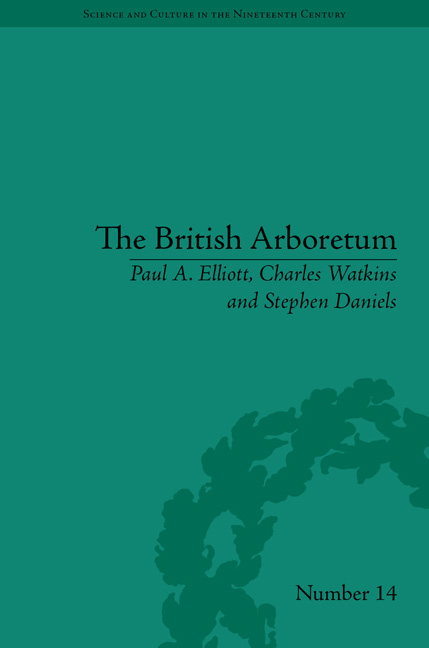Book contents
- Frontmatter
- CONTENTS
- List of Figures
- Preface
- Introduction
- 1 British Tree Cultures in the Nineteenth Century
- 2 Trees and Taxonomy
- 3 British Arboriculture, c. 1800–35
- 4 John Claudius Loudon's Arboretums
- 5 The Botany of the Arboretum Britannicum
- 6 The Derby Arboretum
- 7 Estate Arboretums
- 8 Public Urban Arboretums
- 9 The Transformation of Victorian Public Arboretums
- Conclusion
- Notes
- Works Cited
- Index
Introduction
- Frontmatter
- CONTENTS
- List of Figures
- Preface
- Introduction
- 1 British Tree Cultures in the Nineteenth Century
- 2 Trees and Taxonomy
- 3 British Arboriculture, c. 1800–35
- 4 John Claudius Loudon's Arboretums
- 5 The Botany of the Arboretum Britannicum
- 6 The Derby Arboretum
- 7 Estate Arboretums
- 8 Public Urban Arboretums
- 9 The Transformation of Victorian Public Arboretums
- Conclusion
- Notes
- Works Cited
- Index
Summary
Special places for the cultivation and display of a wide variety of both deciduous and coniferous trees, arboretums developed during the late eighteenth and early nineteenth centuries. They were a combination of plantation, which usually consisted of a few varieties of trees, and botanical garden. Humphry Repton adopted the idea for his landscape gardening commissions followed by John Claudius Loudon. Repton included an arboretum in his red book for Woburn in 1804 and in his design for Ashridge Park, Hertfordshire between 1813 and 1815 alongside a pomarium, rosarium and other eclectic features. Loudon mentioned arboretums in his Treatise on Country Residences (1806) but did not take a special interest in them until later. In his Hints on the Formation of Gardens (1812), for instance, Loudon carefully defined the differences between groves, woods and plantations, without mentioning arboretums whilst in the third book on arboriculture in the Encyclopaedia of Gardening (1824) they were not separately categorized and the term was hardly used. The arboretum idea was always intimately related to written textual manifestations from which it had arisen. Loudon's Arboretum Britannicum (1838),with its wealth of drawings and information, was only the most famous of a series of works that were, in effect, virtual page-bound arboretums, but which were based on detailed observations of trees and collections in specific places.
- Type
- Chapter
- Information
- The British ArboretumTrees, Science and Culture in the Nineteenth Century, pp. 1 - 10Publisher: Pickering & ChattoFirst published in: 2014



